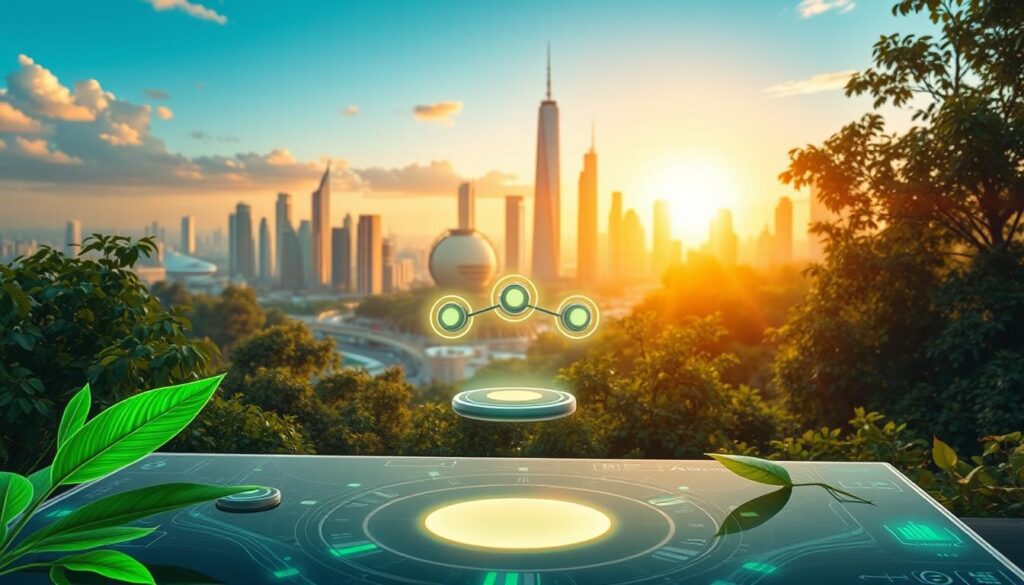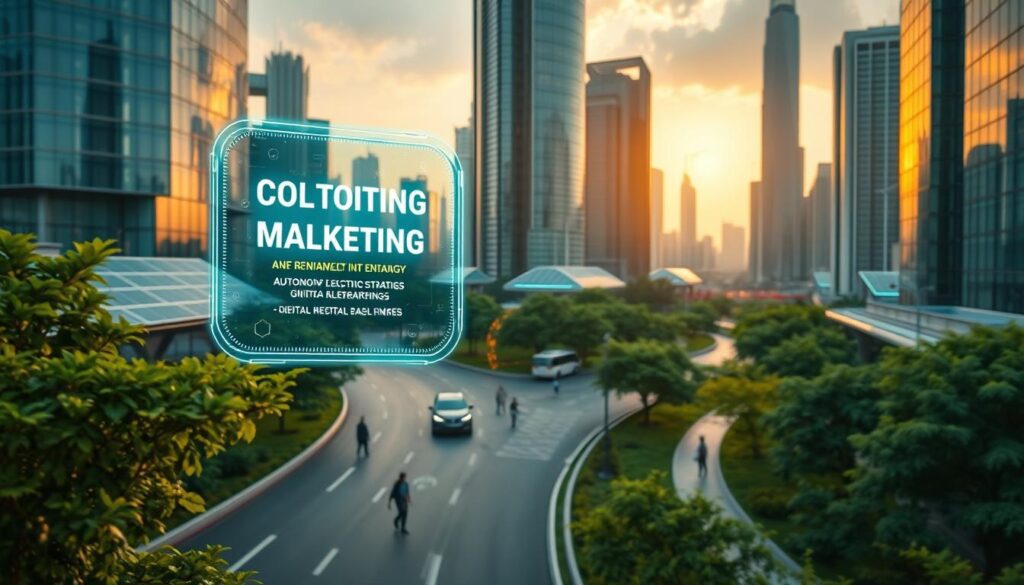Did you know that 81% of consumers now expect companies to contribute positively to the environment? This statistic underscores a significant shift in consumer behaviour, pushing businesses to rethink their strategies. Sustainability has evolved from a mere buzzword to a business imperative, shaping how industries operate in the modern era.
Companies are increasingly integrating eco-friendly content and energy-efficient campaigns to reduce their carbon footprints. This approach not only aligns with consumer expectations but also offers long-term benefits. Studies by Smart Insights and McKinsey highlight the growing importance of adopting sustainable strategies to stay competitive.
As we move forward, the focus on eco-conscious practices will only intensify. Businesses that embrace these changes will not only meet regulatory demands but also gain a competitive edge. This section sets the stage for exploring how these trends are shaping the future of digital marketing.
Key Takeaways
- 81% of consumers expect companies to contribute positively to the environment.
- Sustainability has transitioned from a buzzword to a business imperative.
- Eco-friendly strategies are becoming essential for reducing carbon footprints.
- Adopting sustainable practices aligns with consumer expectations and offers long-term benefits.
- Industry studies highlight the importance of integrating eco-conscious strategies.
Introduction to Eco-Conscious AI and Digital Marketing

Consumer demands are reshaping how brands approach environmental responsibility in the digital space. The integration of eco-conscious strategies has become essential as expectations evolve. Data reveals that 81% of customers now expect companies to take tangible steps towards reducing their environmental impact.
Market research highlights a significant shift in priorities. Brands are increasingly focusing on reducing their carbon footprint through innovative digital tactics. This change is not just a trend but a response to the growing awareness of environmental challenges.
Advanced technology plays a crucial role in this transformation. Tools are now available to measure and mitigate the environmental impact of digital campaigns. For instance, Smart Insights reports that transparency in sustainability efforts is a key factor in building customer trust.
Overcoming these challenges with innovative solutions offers a strategic advantage. Companies that adopt eco-conscious practices are better positioned to meet regulatory demands and consumer expectations. This approach not only benefits the environment but also enhances brand reputation.
Context and Evolving Consumer Expectations
The modern customer is more informed and environmentally aware than ever before. This shift has led to a demand for brands to integrate sustainable practices into their operations. Data shows that companies prioritising environmental impact reduction are more likely to gain customer loyalty.
- Consumers expect transparency in sustainability efforts.
- Brands must address carbon footprint challenges to stay competitive.
- Technology enables precise measurement and mitigation of environmental impact.
By leveraging these insights, businesses can create a more sustainable future while meeting customer expectations. The integration of eco-conscious strategies is no longer optional but a necessity for long-term success.
Sustainable AI Development: Green Marketing Practices for 2025 and Beyond

The intersection of technology and environmental responsibility is reshaping business strategies. Companies are now adopting an integrated approach, combining digital innovation with eco-friendly technologies. This method not only reduces environmental impact but also positions brands as leaders in the evolving market.
Defining the Integrated Approach
An integrated approach involves using advanced tools to measure and mitigate the environmental effects of digital campaigns. For instance, Edge AI applications are being utilised in smart energy management systems, reducing energy consumption significantly. This holistic strategy ensures that businesses remain competitive while contributing positively to the environment.
Transparency in sustainability efforts is another key component. Brands that openly share their progress in reducing carbon footprints build stronger consumer trust. As Smart Insights highlights, this transparency is crucial for long-term customer loyalty.
Strategic Benefits for Future-Focused Brands
Adopting sustainable practices offers numerous advantages. It serves as a powerful tool for market differentiation, helping brands stand out in a crowded marketplace. Companies like Patagonia and Unilever have successfully leveraged these strategies, enhancing their reputation and consumer trust.
Trends such as energy-efficient ad placements and transparent sustainability messaging are reshaping the industry. These practices not only reduce environmental impact but also align with consumer expectations. Brands that embrace these changes are better positioned for the future.
An unwavering commitment to sustainability provides a competitive edge. As the trend towards eco-consciousness grows, businesses that prioritise environmental responsibility will lead the way. This approach not only benefits the planet but also drives long-term business success.
Embracing Eco-Friendly Digital Marketing Strategies

Eco-friendly digital campaigns are becoming a cornerstone of modern brand communication. As consumer expectations evolve, businesses must adapt to meet the demand for environmentally responsible practices. This shift is not just a trend but a necessary change to align with global climate goals.
Sustainable SEO and Content Optimisation
Optimising content for search engines while reducing energy consumption is a key strategy. Sustainable SEO practices, such as using evergreen content and efficient coding, lower the digital carbon footprint. These methods not only improve search visibility but also contribute to a brand’s sustainability goal.
For instance, fast-loading websites reduce energy usage by up to 70%. This approach enhances user experience while aligning with eco-conscious values. Brands that prioritise these practices gain a competitive edge.
Green Ad Placements and Energy-Efficient Campaigns
Energy-efficient ad placements are another critical component. By targeting eco-conscious audiences and using renewable energy for hosting, brands can significantly reduce their environmental impact. Studies show that such strategies can lower emissions by up to 30%.
Companies like Patagonia have successfully implemented these campaigns, resulting in higher customer engagement and trust. This demonstrates the value of aligning digital strategies with environmental responsibility.
Transparent Sustainability Messaging
Transparency is essential in building consumer trust. Brands that openly share their progress in reducing their carbon footprint are more likely to gain loyalty.
“88% of consumers trust brands that are transparent about their environmental impact,”
according to recent data.
Clear communication of goals and achievements helps brands stand out. For example, IKEA’s commitment to renewable energy and recycled materials has strengthened its reputation. This approach not only meets consumer expectations but also sets a benchmark for the industry.
As the digital landscape evolves, integrating eco-friendly strategies will play a pivotal role in shaping brand success. To learn more about the top trends shaping marketing in 2025, explore our detailed insights.
Leveraging AI Technologies for Environmental Impact
Innovative tools are now at the forefront of addressing global challenges. Among these, advanced systems are playing a pivotal role in reducing environmental impact. By optimising processes and enhancing efficiency, they offer a unique opportunity to tackle pressing issues like climate change and resource management.
Generative and Edge AI in GreenTech
Generative AI is transforming industries by creating solutions that minimise waste. For instance, it’s being used to design energy-efficient buildings and optimise supply chains. Edge AI, on the other hand, enables real-time data processing, reducing energy consumption in smart grids and renewable energy systems.
These technologies are not just theoretical. Companies like Siemens and Tesla are already leveraging them to achieve significant progress in sustainability. By integrating these tools, businesses can reduce their carbon footprint while maintaining operational efficiency.
Quantum and Analytical AI Insights for Sustainability
Quantum AI offers unparalleled precision in measuring environmental impact. It enables the analysis of complex datasets, helping industries identify the most effective way to reduce emissions. Analytical AI, meanwhile, provides actionable insights for predictive maintenance, ensuring resources are used efficiently.
For example, in the energy sector, these technologies are being used to forecast demand and optimise renewable energy production. This not only supports growth but also ensures a sustainable future. However, it’s crucial to balance their benefits with the energy they consume.
“AI-driven solutions are reshaping industries, but their environmental impact must be carefully managed,”
By adopting these technologies responsibly, businesses can lead the way in sustainable innovation. To explore how AI is transforming other sectors, check out our insights on the AI vs human battle for call center.
Overcoming Challenges in Sustainable Digital Marketing
Adopting eco-conscious strategies in digital campaigns is no longer optional but a necessity for modern businesses. However, transitioning to more environmentally friendly practices comes with its own set of challenges. From high energy consumption to the costs of integrating new technologies, businesses must navigate these barriers to achieve their sustainability goals.
Identifying Barriers to Eco-Friendly Practices
One of the primary challenges is the resource-intensive nature of traditional digital campaigns. High energy consumption, particularly in data centres and ad placements, significantly contributes to a brand’s carbon footprint. Additionally, the initial costs of adopting sustainable technologies can be prohibitive for many businesses.
Another barrier is the lack of measurable sustainability goals. Without clear targets, it’s difficult to track progress or demonstrate environmental impact reductions. This can lead to scepticism among consumers, who increasingly demand transparency and accountability.
Implementing Practical and Cost-Effective Solutions
To overcome these challenges, businesses can leverage data-driven insight to identify areas for improvement. For instance, switching to energy-efficient hosting providers can significantly reduce environmental impact. Similarly, green advertising platforms offer a more sustainable alternative to traditional ad placements.
Setting measurable sustainability goals is another crucial step. These goals should be specific, achievable, and aligned with broader environmental targets. For example, a company might aim to reduce its carbon emissions by 20% within the next two years.
- Use energy-efficient hosting to lower carbon emissions.
- Adopt green advertising platforms for eco-friendly campaigns.
- Set clear, measurable sustainability goals to track progress.
Aligning the supply chain with eco-friendly practices can further enhance a brand’s sustainability efforts. This includes sourcing materials responsibly and minimising waste throughout the production process.
“Businesses that prioritise sustainability not only meet regulatory demands but also build stronger relationships with eco-conscious consumers,”
By addressing these challenges head-on, companies can position themselves as leaders in the shift towards more sustainable digital practices. For more insight on integrating eco-friendly strategies, explore our guide on the eco-AI approach.
Future Trends and Cutting-Edge Innovations in Green Marketing
The future of eco-conscious strategies is being shaped by groundbreaking innovations and evolving regulations. As industries adapt to new demands, businesses are exploring advanced frameworks to reduce their environmental footprint while maintaining competitive advantage. This section delves into the latest trends driving this transformation.
Emerging Carbon Markets and Biodiversity Credits
Carbon markets are expanding rapidly, offering businesses a solution to offset emissions effectively. Biodiversity credits are also gaining traction, enabling companies to invest in conservation projects. These mechanisms not only address environmental challenges but also create new revenue streams.
For instance, platforms like Gold Standard are facilitating transparent carbon offset projects. This action ensures accountability and builds consumer trust. As these markets grow, they will play a pivotal role in achieving global climate goals.
Innovative Eco-Labelling and Transparent Communication
Eco-labelling is evolving to provide clearer insights into a product’s lifecycle impact. Digital labels, for example, allow consumers to scan QR codes for detailed information. This transparency simplifies decision-making and fosters trust.
Brands like Patagonia are leading the way by integrating lifecycle impact labels into their products. This approach not only meets consumer expectations but also sets a benchmark for the industry. Clear communication is essential for building long-term loyalty.
AI Regulation and Responsible Technology Use
As technology advances, regulations are being introduced to ensure ethical use. AI-driven tools must balance innovation with accountability. For example, the EU’s AI Act sets guidelines for transparency and fairness in AI applications.
“Responsible technology use is critical to building trust and ensuring long-term success,”
Businesses that adopt these frameworks position themselves as leaders in ethical innovation. This commitment not only enhances reputation but also drives sustainable growth.
Investment in AI-driven solutions is a catalyst for market innovation. Companies that prioritise these technologies are better equipped to meet evolving demands. By integrating responsible practices, they can achieve both environmental and business goals.
Conclusion
Businesses today face a critical need to align with eco-conscious strategies to stay relevant. Integrating advanced technologies into digital campaigns offers a competitive edge while reducing environmental impact. These strategies not only meet consumer expectations but also drive long-term growth.
Adopting energy-efficient systems and transparent communication builds trust. Challenges like high energy consumption can be addressed through innovative solutions. For instance, optimising server workloads and using renewable energy sources significantly lower emissions.
Emerging trends, such as carbon markets and eco-labelling, are reshaping industries. These advancements provide measurable ways to contribute positively to the environment. By embracing these practices, companies can position themselves as leaders in ethical innovation.
The power of integrating eco-friendly strategies lies in their ability to build resilient, future-proof brands. Businesses that prioritise these changes will not only thrive but also contribute to a healthier planet.
Want to hire me as a Consultant? Head to Channel as a Service and book a meeting.

